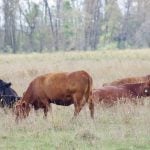A decade of vision, hard work and reliable funding is paying off, as long-term organic rotation studies reveal important lessons for the future of organic systems.
The studies each include three rotations. The rotations range from simple crops to more complex annual rotations and some with perennial forages.
Each study compares these organic rotations to similar rotations high inputs, reduced tillage or both.
The Glenlea study, near Winnipeg, compared a wheat-pea-wheat-flax rotation, a wheat-clover-wheat-flax rotation and a wheat-alfalfa-alfalfa-flax rotation.
The Alternative Cropping Study, or ACS, at Scott, Sask., compared a lentil green manure-wheat-wheat-lentil green manure-canola-wheat rotation with a lentil green manure-wheat-pea-barley-sweetclover-canola rotation and a canola-wheat-barley-alfalfa-alfalfa-alfalfa rotation.
Read Also

Worrisome drop in grain prices
Prices had been softening for most of the previous month, but heading into the Labour Day long weekend, the price drops were startling.
The Flexible Dryland Cropping Study, or FDCS, at Lethbridge compared a sweetclover-wheat-sweetclover-wheat rotation with a sweetclover-wheat-pea-flax rotation and a winter triticale and red clover-flax-wheat-barley and pea rotation.
Each study compared yields under different management.
The Glenlea and ACS studies showed somewhat lower yields on organic rotations than on high input rotations.
Good flax yield was possible in forage rotations when weeds were well controlled by the rotation.
When weed populations were higher, delayed seeding was needed in addition to the rotational effects to maintain flax yields.
The late-seeded organic flax did not yield as well as early-seeded high input flax, but its economic returns were roughly three times as great.
In the ACS study, economic returns for organic rotations were favourable relative to high input systems, even if premiums could be achieved on only half of the organic crops.
In the FDCS study, returns were higher under organic than under low input management in favourable years. In drought years, yields were less.
Soil fertility was also a concern. Analysis at the Glenlea study indicates that organic alfalfa rotations are depleting soil phosphorus. Nitrogen levels are also lower on the annual organic rotations.
The ACS showed that phosphorus depletion was an issue on all organic rotations, and nitrogen balance was problematic if green manures were used less frequently than one year in two.
In the FDSC, with greater frequency of green manure and with composted animal manure in the forage rotation, neither nitrogen or phosphorus levels are depleting relative to low input rotations.
Greater weed pressure was evident in organic rotations at Glenlea. These pressures are being addressed in the research by greater crop diversity to increase competition.
In the ACS study, weed competition was highest for the organic systems, but generally had a smaller impact on yields than the supply of soil nutrients.
In the FDCS study, weeds were well controlled in sweetclover rotation, but less well controlled when peas were used to replace sweetclover eaten by weevils.
Both the Glenlea study and FDCS examined crop quality. Organic flax had higher levels of micronutrients at Glenlea, and at FDCS organic forage was of higher quality than low input forage.
Organic flax also had more mycorrhizae, soil organisms helpful in nutrient uptake, than flax from other systems.
Environmental concerns were also addressed.
The ACS showed that organic rotations use roughly 40 percent as much energy as it takes to produce chemical fertilizers.
A concern for organic producers is the potential for erosion in systems that rely on tillage.
In the ACS study, organic rotations had less protective residue cover than either high input or reduced input systems.
This was especially severe in 2003, when grasshoppers removed most crop residues.
The FDCS rotation offers some hope. In this study, cover crops were mulched rather than incorporated, providing effective weed control, retention of moisture and increased soil nitrogen.
Reduced tillage in organic systems should reduce erosion potential. Each of these studies suggests that organic systems have potential. Economic yields are possible with good management. Organic systems offer benefits and challenges.
Organic production requires attentive observation and proactive management if it is to be truly sustainable. Research projects across the Prairies are helping to guide these efforts.
For specific information about the Glenlea project, contact Martin Entz at 204-474-6077 or m_enzt@umanitoba.ca or visit the website at http://www.umanitoba.ca/afs/Plant_Science/glenlea/results00_01.html.
For specific information about the Alternative Cropping Study, contact Stewart Brandt at 306-247-2011 or brandts@agr.gc.ca.
For specific information about the Flexible Dryland Cropping Study, contact Jill Clapperton at 403-327-4561 or clapperton@agr.gc.ca.
Brenda Frick, Ph.D., P.Ag., is the Prairie Coordinator for the Organic Agriculture Centre of Canada at the College of Agriculture, University of Saskatchewan. She welcomes your comments at 306-966-4975 or via email at brenda.frick@usask.ca. For more information, visit the websites at www.organicagcentre.ca/ and organic.usask.ca/.














